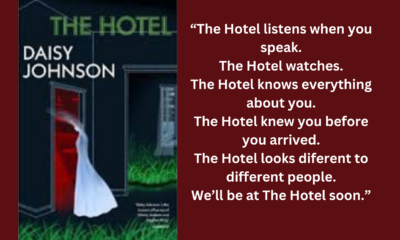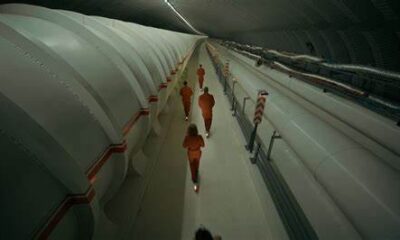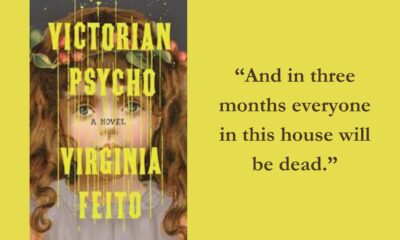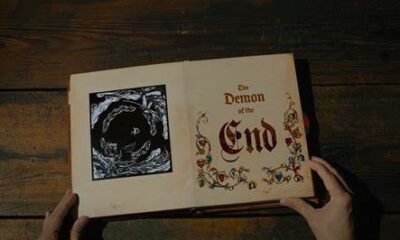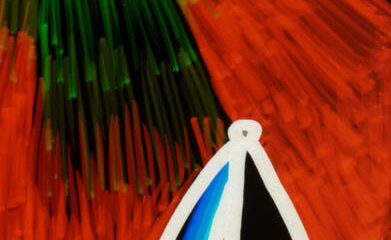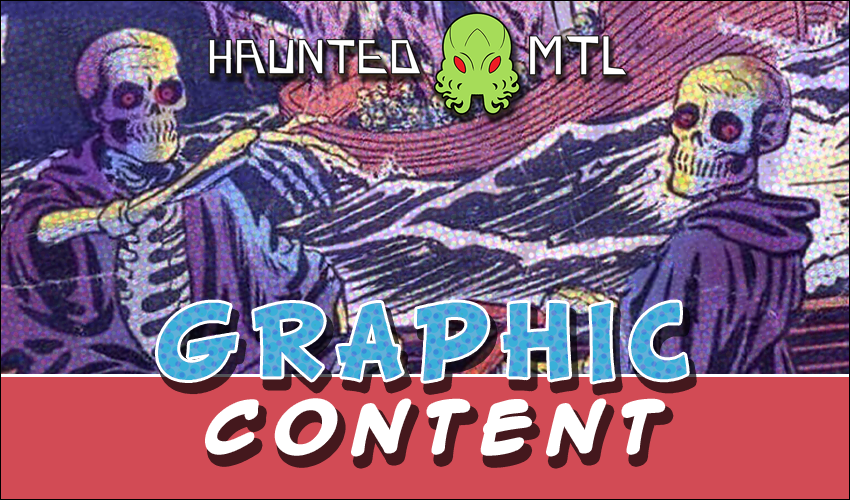
Graphic Content #8
More Videos
Published
4 years agoon
Life comes are you real fast sometimes, especially this year. I keep telling myself I am going to be doing these bi-weekly but then before you know it a whole damn month has passed.
But that is okay, the comics are still there, waiting. Watching.
Welcome to Graphic Content #8. Since the previous stack of reviews, I launched a special, Swamp Thing-centric series called, what else, “Just Swamp Things.” So if you are asking where Graphic Content #7 is… well, that is it. I am hoping to alternate between the regular comic reviews and the Swamp Thing retrospective.
Anyway, let’s turn now to our ongoing titles.
John Constantine: Hellblazer #9

Simon Spurrier brings another creature of myth and legend into Constantine’s world with “The Favourite.” The issue also reintroduces Matías Bergara as the artist, again working with Jordie Bellaire as the colorist.
I’ve really come to appreciate the Constantine-take on the contemporary UK. Not living there I am sure there is a great deal that I am missing out on as I read this series, but Spurrier’s writing is strong enough that I can piece a great deal together from it. What isn’t hard to piece together is the disdain for the Royal institution presented in the issue. Maybe not the Queen, so much, but rather the extended family.
The plot of this week’s episode follows as Constantine is compelled to investigate the birthing of a foal from a prized Royal race-horse, which normally seems outside of his domain, but thanks to the machinations of his older double rumbling around the island, it becomes part of his overarching work of unwinding the tangles of Old Man Constantine.
The issue has many great hallmarks of HellBlazer‘s best stories: the grosser side of magic, the leftist politics, plenty of dodgy swears. It’s all great fun, but it also does a great job of building on the current era the title established. We see the return of Tommy Willowtree, albeit briefly when he is consulted by John. We also get a fun moment with Nat, the bouncer to the pub John frequents. It really feels like Spurrier’s take has come into its own, and this is a world I want to spend more time with. I am do feel John’s tendency to narrate his story is a little too close to the previous storyline, however, perhaps if the series didn’t dip into that well again so immediately I would have liked it a bit more. The story is fine, and it is by no means bad, but it does feel like the past three issues are running together, at least in concept.
As far as the art goes, I think Bergara is my favorite artist on the run. I like how dodgy he makes John look, and the combination of Bergara on the illustrations with Bellaire on the color is an absolute win, especially at the “birthing” scene in all it’s bloody glory.
 (4 / 5)
(4 / 5)
John Constantine: Hellblazer #9, written by Simon Spurrier and illustrated by Matías Bergara, is available from DC Comics.
Sink #6
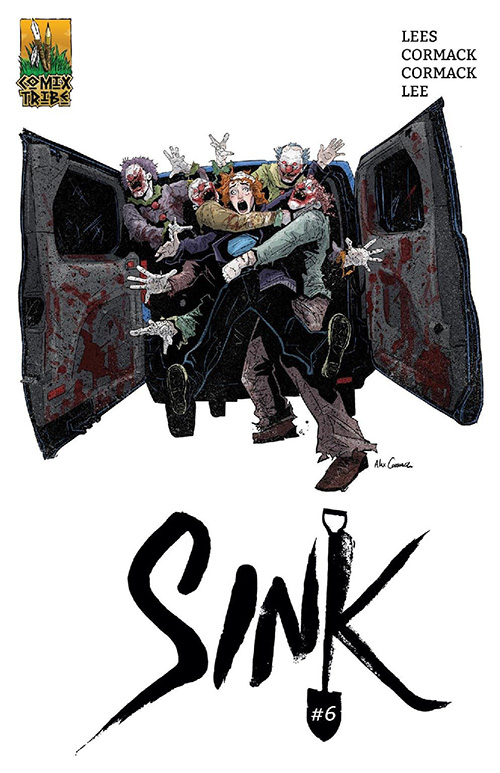
Oh dear lord… the Clowns are back. With a cover that would send any sufferer of coulrophobia into a panic, Sink‘s “Death and the Midden” by series regulars John Lees (story) and Alex Cormack (illustration) promises to be full of the Sinkhill charm of the previous five issues, but also carry the menace of the roaming gang of clowns who have been glimpsed around the events of the stories.
The story told in this issue isn’t necessarily a unique one, beyond the fact it has a roving gang of drugged up torture clowns. The issue follows an assault/revenge narrative with the heroine begin subjected to excessively brutal torture only to be then subjected to a chase where she turns the tables on those who assault her. Largely without dialogue, aside from screams, grunts, and wheezing clown laughs, it’s an effective story told in silence and seems to suggest how the clowns that roam Sinkhill are made.
“Flats,” the backup feature, also presents some interesting wrinkles into the world of Sink. This one-page story introduces a suicide spot that may be more than it seems, and I am curious as to how this setting may develop or be integrated into other stories. Also, as a rather nice bonus for this issue, is a brief essay by series writer John Lees discussing influences on Sink and this issue in particular. It is fun to get such insights that you would normally need to wait for a trade to see.
While normally Cormack’s art really works for me, I feel the sequence in the rain, the majority of the issue, was fairly hard to parse. I understand that it is certainly chaotic and moody, but it also is just hard to figure out what one is looking at, at times, especially given that so much of the background is just a dark void. There is a grittiness and messiness to Sink that absolutely works, but I fear this episode carried it a bit too far at the cost of legibility. between the heavy black ink, the rainy white streaks, and the copious amounts of blood, I didn’t find myself reading through the panels as fluidly as I had hoped.
 (3.5 / 5)
(3.5 / 5)
Sink #6, written by John Lees and illustrated by Alex Cormack, is available on Comixology.
Killadelphia #9
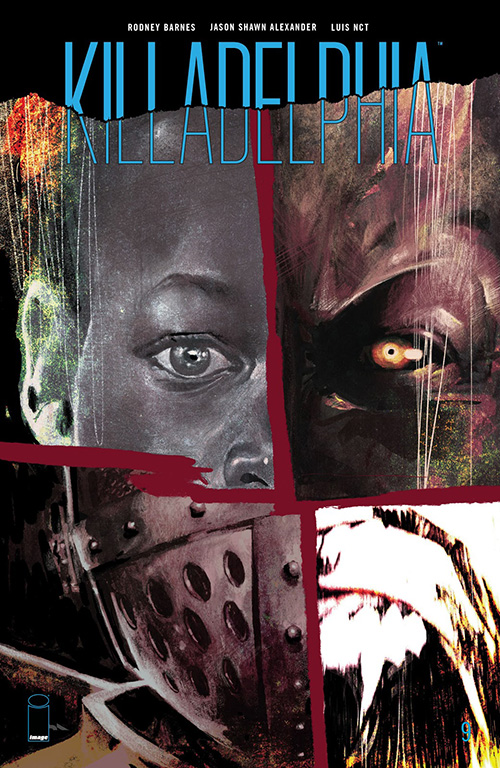
We make a return to the bloody, bloody streets of Philadelphia with writer Rodney Barnes and artist Jason Shawn Alexander in a rather thrilling and dramatic installment this week. The third part of Killadelphia‘s “Burn Baby Burn” arc, “The Dance of Death” picks up immediately after the previous issue, with James Sr. being brought up to speed after being dug up by his son. The immediate tension of the conversation is fantastic given the glimpse of the afterlife Sr. had experienced before his son dug him up, and that tension carries throughout the issue. James Sr. absolutely evicerates throughout the story and despite his obvious protests, the comic is richer with him being around.
A couple of threads are picked up in this issue, such as the return of the vampiric child Brittany, who has an interesting conversation with Abigail Adams in the first few pages. As for whether Abigail’s scheme makes sense in the grand scheme of things, that remains to be seen. Jupiter, the new, big bad vampire introduced at the start of the arc, also gets a detailed backstory that pulls in another president into this world of Barnes’ making, one that thematically is perfectly fitting to the whole story. It is a very exciting direction and complication to the series. The issue ends on one hell of a cliffhanger with three different “oh shit” moments. It’s quite an impressive confluence of events.
Killadelphia‘s art continues to impress. While earlier issues did have their elements I quibbled with as far as the inking style and the abstractness of some of the character art, that has more or less disappeared here, with character likenesses feeling very much fleshed out. I do feel like there can be an over-reliance on void panels, however. Not that every background needs to be fully fleshed out, but given the rougher and more impressionistic work of Jason Shawn Alexander it can be odd to see a panel that the background is absent. It obviously puts emphasis on the character, but even just a hint of the structures behind the character would be useful, I think
 (4 / 5)
(4 / 5)
Killadelphia #9, written by Rodney Barnes and illustrated by Jason Shawn Alexander, is available from Image Comics.
I am still on the hunt for horror titles to review, so as always, send your suggestions my way. I am planning on introducing a couple of new titles soon, as well. Until then, stay tuned for the next installment of Graphic Content.
Related posts:
David Davis is a writer, cartoonist, and educator in Southern California with an M.A. in literature and writing studies.

You may like
Horror in graphic novels
Read Hide if you need a dark graphic novel to talk about over Thanksgiving
Published
4 months agoon
November 24, 2024Thanksgiving is coming up this week if you live in America. And many of us are going to be in contact with younger relatives. And some of you might be on a mission to be the cool/bad influence relative that introduces them to the horror genre. If so, I have just the graphic novel for you.
Published in September of 2023, Hide is based on the novel of the same name by Kiersten White. It was adapted into a graphic novel by Scott Peterson, and illustrated by Veronica and Andy Fish. It tells the story of fourteen people who believe they are in a reality show, playing Hide and Seek in an abandoned theme park. It should surprise absolutely no one to find out that the creators of the show have something much darker in mind.
The story
Our main character is Mack. She’s had about the worst rough start to life one could imagine and is currently living in a homeless shelter. There, she’s given the opportunity to participate in a game show, playing hide-and-seek.
I like to think that if the shelter manager had known of Mack’s horrific past, she wouldn’t have ever made that suggestion.

Mack signs up and soon finds herself in an abandoned amusement park with thirteen strangers. The rules are simple. Hide during the day, and be the last person found. Of course, this is nothing but a lie. There will be no winners, only victims.
What works
The first thing we have to talk about is how Hide the graphic novel compares to Hide, the original book. Of course, there wasn’t going to be enough room for every single part of the story. There were some cuts. But it doesn’t feel like anything essential was cut here. The characters remain the same. The storyline is still there, sans any structural issues. Often, this is a difficult thing to do. Some stories don’t translate from one medium to another. But Peterson did a wonderful job.
Of course, we can’t talk about a graphic novel without talking about the art. And the art in this book is fantastic. The colors are rich and vibrant. Everything looks exactly like one might picture it when reading the novel.
Except for the monster, which I have to admit I pictured more like a Rat Creature from Bone.
My favorite part was the journal entries. I loved the cryptic sigils that are scribbled over the page without explanation. I loved the different handwriting. I loved the clippings of newspapers and pictures. The whole thing was just wonderfully, eerily, immersive.
Finally, I want to point out that Hide is a great graphic novel even if you’ve never read the book, and never intend to. This is not a companion for the book. It tells the story all on its own. And yes, reading a graphic novel is just as valid as reading any other novel. This is just a good story, with good artwork. No other reading is necessary.
What didn’t work
There was only one thing I didn’t love about Hide. And that was the ending.
It’s usually the ending.

In the novel, the ending is ambiguous but satisfying. This ending was, without ruining it, a little more ambiguous. There are questions I really wanted answers for that I didn’t get. There is at least one character that I’d like to know about. Are they okay? I don’t know. And this ending doesn’t even really give us a hint. All we can do is hope.
If you are going to be picking this up for a younger person, be aware that there is some rough language. There are also a few graphic scenes of violence, so if that’s the sort of thing that will get you banned from further holiday events, be aware. But if you have a tween or teen who needs to be encouraged to delve into the creepy side, Hide is a great way to do it. Of course, there’s no shame in just reading it yourself.
 (4.5 / 5)
(4.5 / 5)
Book Reviews
Vermis II: Mist & Mirrors, a Book Review
Vermis II: Mist & Mirrors is a graphic novel by Plastiboo, acting as the “official guide for a game that doesn’t exist.”
Published
7 months agoon
September 17, 2024Vermis II: Mist & Mirrors is a graphic novel by Plastiboo. The team behind the work includes Plastiboo as the artist, Hollow Press as the publisher, Michele Nitri as the editor, Christian Dolz Bayarri as the graphic designer, Marco Cirillo Pedri as the graphic supervisor, and E.R. as the English editor and proofreader. The Vermis collection seems sold out in its current editions, but I still recommend ordering from the original publisher, Hollow Press.
Who stares back from the dark glass? The Wayfarer travels–cursed and haunted by their past–through the distant lands and places within the Mist & Mirrors. Endure a corrupt world and struggle to fend off the curses that mark you. Venture forth, Wayfarer, and perhaps find peace and salvation.
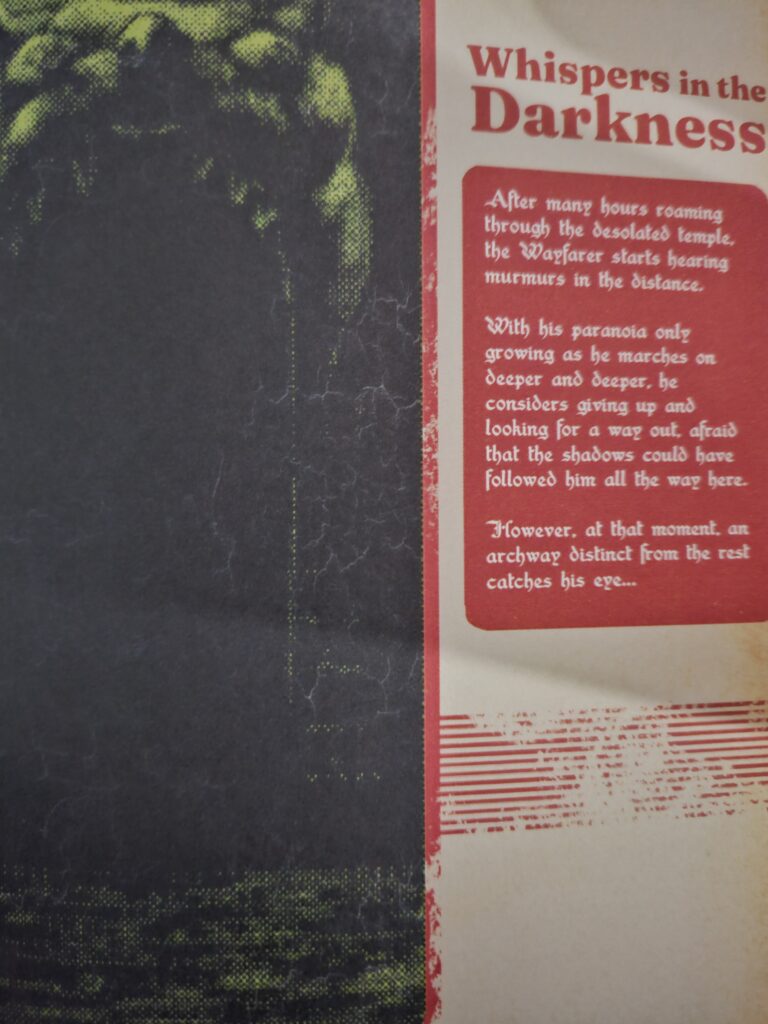
What I Like about Vermis II: Mist & Mirrors
The premise remains an “official guide” to a game that does not exist. However, one key distinction that stands out is the corrosion of this “official guide” mark, suggesting Mist & Mirrors centers itself as a graphic novel. In this sense, it more accurately hits its vision while providing an engaging story.
Mist & Mirrors places its character selection at the end of the graphic novel, instead, choosing a character and allowing the reader to follow that journey. While this moves away from the “official guide” concept, it better fleshes out the world and creates a more independent product.
Where Vermis I held a heavy retro-game aesthetic, Vermis II takes this to the next level while adding a wider range of color than the original. Not only does this add more aesthetic variety, but it also vastly improves readability. My greatest critique of the first graphic novel was the general lack of readability that impacted the experience, but Mist & Mirrors seems to take this to heart. Beyond the variety and improvement, the design changes the color themes to match the distinct lands the “Wayfarer” embarks on, giving a direct purpose to the changes.
On starting the graphic novel, I half expected a spiritual successor set in a new world. While its setting certainly differs from the original, Mist & Mirrors expands on the lore and history. In fact, the exploration of Mist & Mirrors adds value to the original and encourages a re-read. Honestly, that’s what all sequels strive (or should strive) to succeed.
Despite the colorful innovation, Vermis II: Mist & Mirrors delivers that same bleak horror popularized by Dark Souls. It still wears its inspirations on its sleeves while better communicating its “game mechanics.”

Tired Tropes and Triggers
Again, there aren’t many points worth mentioning regarding tropes or triggers. As the graphic novel takes themes and trends from the Soulslike genre, it’s dark and bleak but not overwhelmingly so.
Payment and delivery (for American audiences) still come with a 15 to 45-day wait period with little room for verification or updates. The process through PayPal remains seamless, and I received the novel within the timeframe, but it’s a consideration.
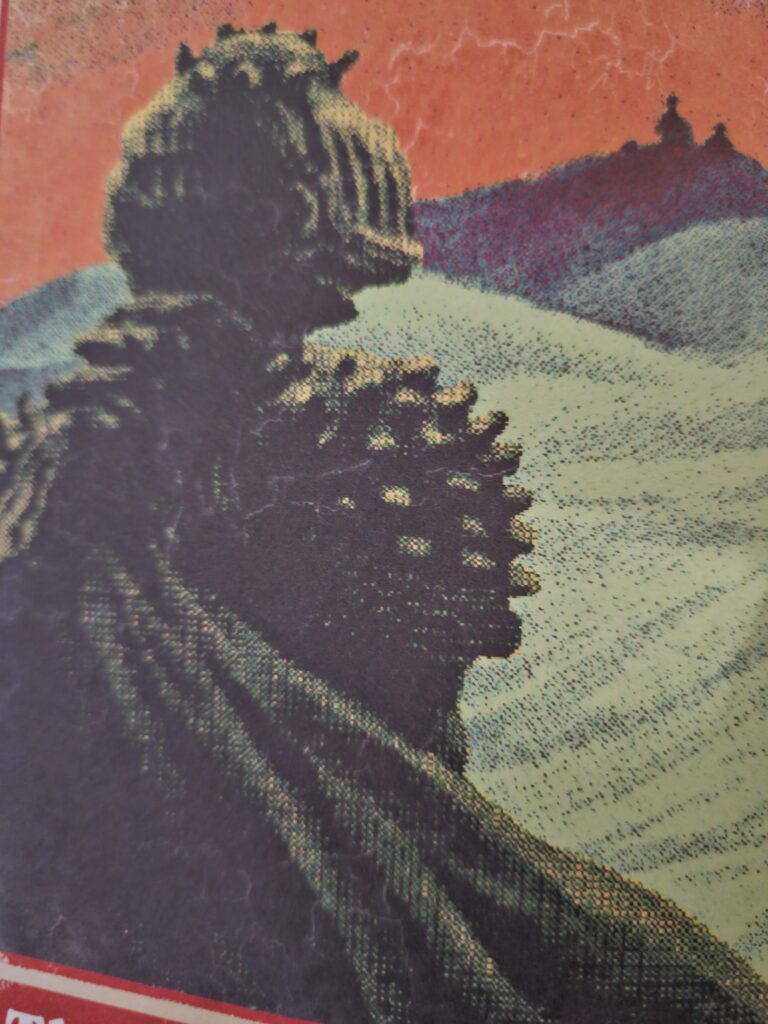
What I Dislike about Vermis II: Mist & Mirrors
While there are notable points to mention in this section, Mist & Mirror vastly mitigates Vermis I’s core issues. However, that isn’t inherently the same as fixing them in some cases. For example, readability remains a slight issue. I will emphasize it as a slight issue with the vast improvements implemented.
For those fans of the specific niche that Vermis aims to deliver, Mist & Mirrors tones down the “official guide” aspect. Instead, it favors a more straightforward narrative that follows a specific character. This brings life to the “game world” and makes an independent product but limits Vermis I’s game guide concept.
On a more personal note, I did enjoy the concept of Vermis I’s classes over the classes of Mist & Mirrors. Naturally, there are some interesting concepts, but nothing haunts me like the Infant Seeker or Rat Man. However, the new choices seem to provide a stronger narrative and backstory.
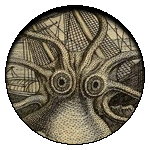
Final Thoughts
Vermis II: Mist & Mirrors vastly improves in many aspects of the original, telling a story set in its bleak and fascinating world. While it does veer from the original concept, it does so to make a more independent product. If you are looking to lose yourself in a strange world or dive deeper into Vermis’ underexplored lore, Mist & Mirrors seems tailor-made for you.
Published in April of this year, Bad Dreams in The Night is a collection of horror comics by the artist and author Adam Ellis. With the description stating that it is a graphic novel version of Scary Stories to Tell in the Dark, I had to get my hands on it. And it did not disappoint.
The stories
Bad Dreams in the Night consists of eleven short horror stories. I honestly don’t think there’s a bad one in the whole bunch. So let’s just highlight a few.
Easily my favorite story in the book was Little House in the Sea. It’s a sweet, eerie little tale that seems like a pinprick view into a dark and horrifying world. It left me with so many questions that I fear will never have answers. The story is about a young woman and her mother, who live on a little island all alone. The young woman is never to ask about what is on the other side of the sea. Then, her mother dies. And everything changes, but not by a lot.
Green Ribbon was another great story. It’s a retelling of the classic Girl With a Ribbon story from the original Scary Stories book, in which a man is confused and eventually angry that the love of his life wears a ribbon around her neck and won’t tell him why. I liked this updated version. It’s a stark reminder that just because we marry someone, we aren’t owed all of their secrets.
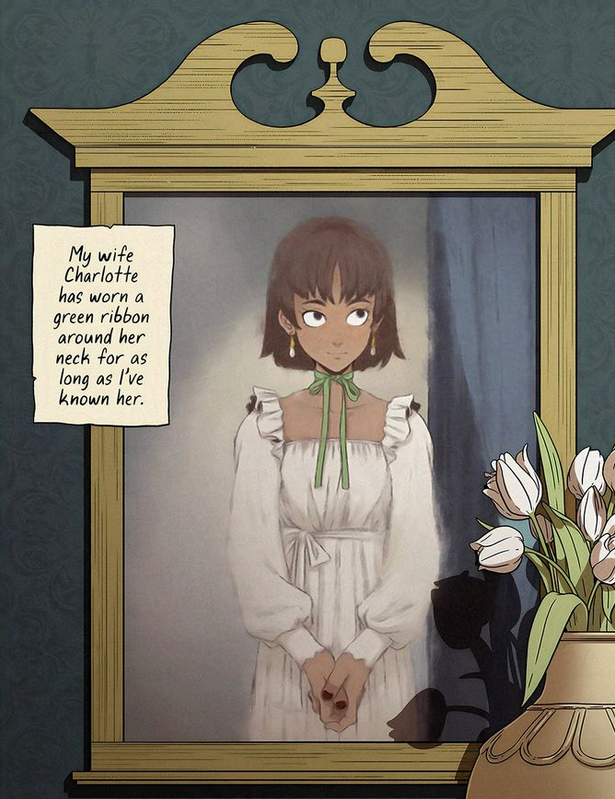
What worked
Of course, the first thing I have to point out about Bad Dreams in the Night is the fantastic artwork. Ellis was a cartoonist first, and it shows.
The artwork is part of the storytelling as well. The best example of this is the story Better Kate Than Never. The younger sister character, Taffy, has such an animated face during the scenes with a ‘studio audience’. When she is just herself, her face is flat, and far more mature than we’d expect for a girl her age.
Though, I suppose based on the story, she might be any age.
Another really enjoyable thing was the mini-essays at the end of each story. As a creator myself, I love the little peeks into the creative process. I know how I come up with stories. But it’s different for everyone, and the story behind the story is often just as fun.
Finally, I have to praise a feature that applies to Ellis’s work overall, not just this book. Whenever he writes scary stories (and he has posted quite a few on his social media) they are a fascinating blend of cute and horrifying. The artwork always has a lovely, innocent, cartoonish look. The children always look like cartoon children, with exaggerated large heads and wide circular eyes.
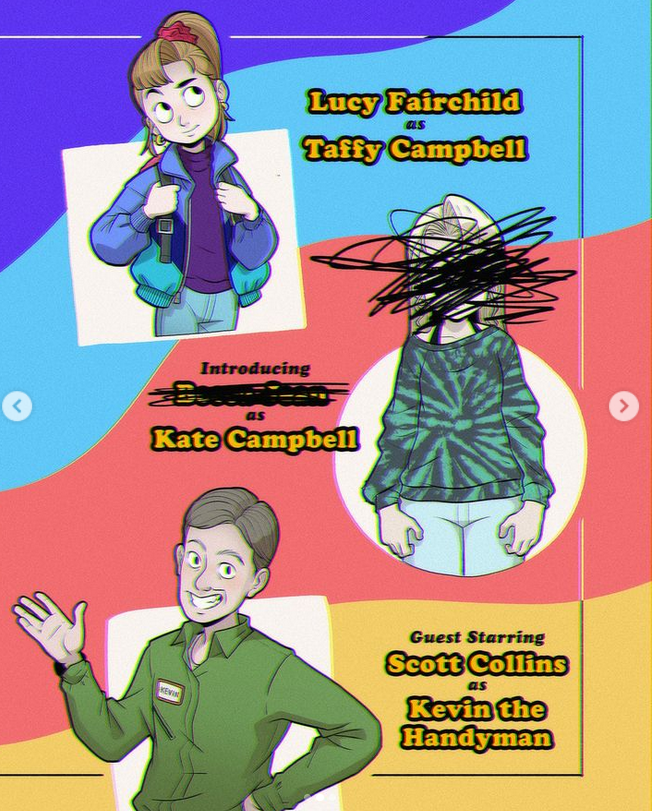
At the same time, Ellis doesn’t pull any punches when it comes to the blood and gore. One story in particular, Milk Door, is a perfect example of this. I don’t want to spoil the ending for you, but it is graphic, horrifying, and wonderful.
What (kind of) didn’t work
I only have one issue with this book. If you follow Ellis on social media, you’ve likely seen at least some of these stories before.
Though, even as I say this, I’m not sure what could have been done about it. Only the beginnings were shown on Instagram. This was a marketing tactic and an effective one. You get the setup for free, but you have to read the book for the punchline.
Bad Dreams in the Night was a really enjoyable way to spend a few hours. In the end, my only real complaint is that it could have been longer. But of course, that is one of the chief rules of entertainment. Always leave people wanting more.
(usr 5)
By the way, if you like this you might enjoy my haunted apartment novella, Quiet Apocalypse. The main character is a modern witch, and I share some real magic in this fictional story of an unexpected end of the world.

